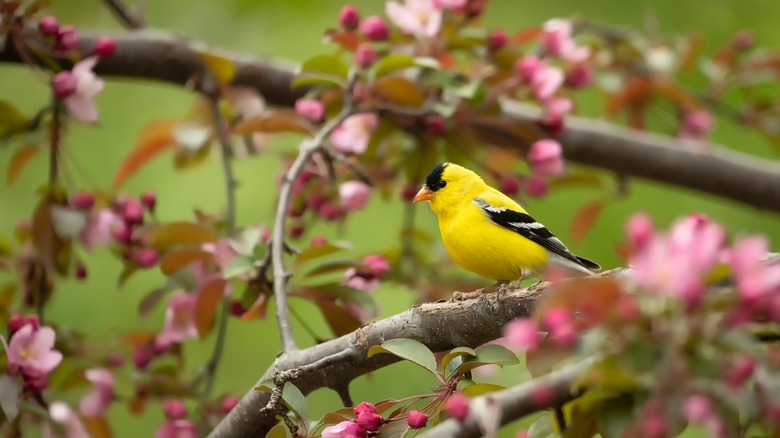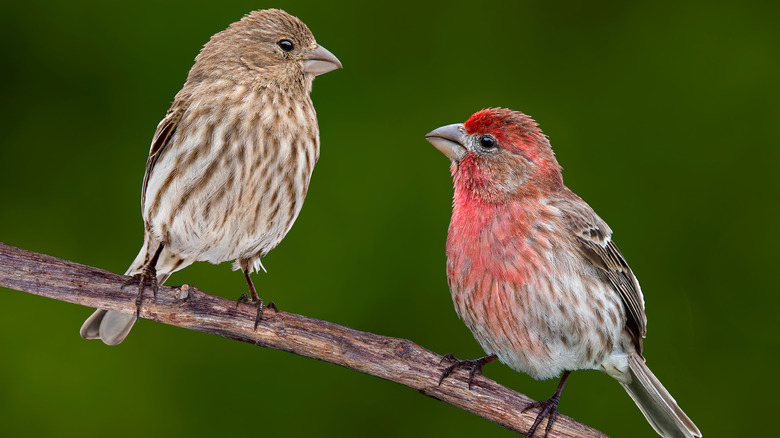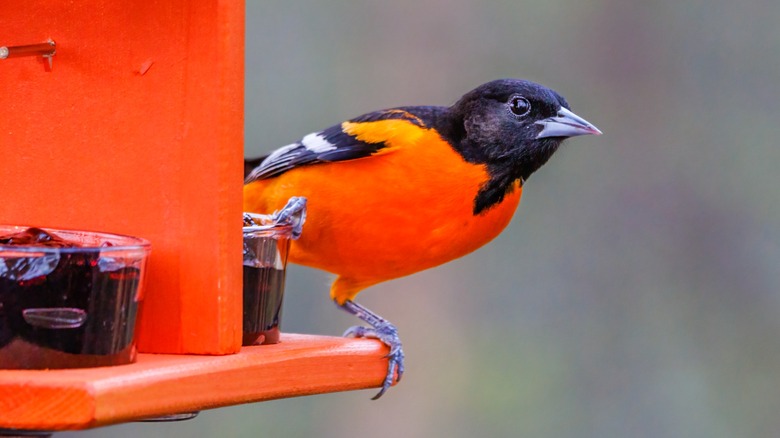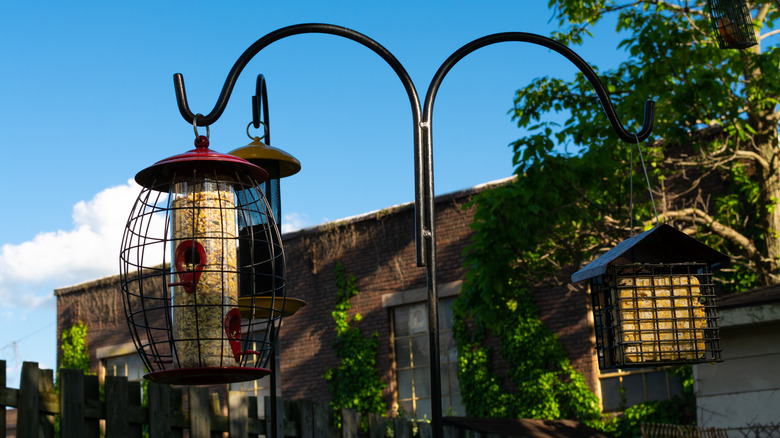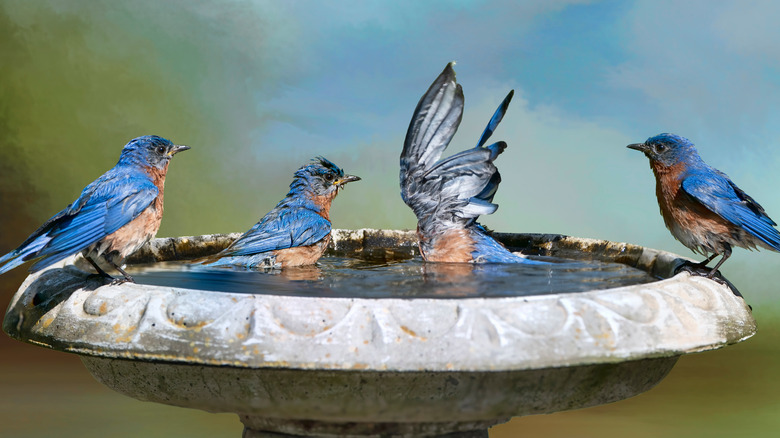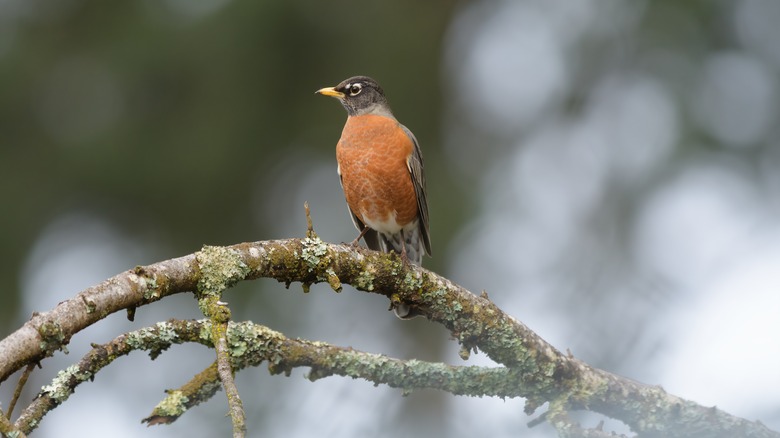How To Attract More Songbirds To Your Yard
We may receive a commission on purchases made from links.
Birdwatching is a fun and relaxing way to connect with nature. While birding while hiking is great for your cardiovascular health, so is backyard birdwatching. As Birds & Blooms states, you don't need to leave your own yard to reap the benefits of watching these amazing creatures in their natural habitat. In a study published in the journal Ecopsychology, researchers found that being outdoors in nature increased feelings of both positiveness and energy.
One might conclude then that simply watching a bird feeder for a few minutes could improve your psychological health. Birds & Blooms also cites another study conducted in the UK, where researchers discovered that residents of neighborhoods with higher bird populations stated they felt less anxious and stressed.
Although the health benefits alone are enough of a reason to attract more songbirds to your yard, the beauty and natural music they add to your space are like nature's works of visual and audible art. With a few simple changes, you can reap all the benefits of backyard songbirds. As Mark Obmascik states in his book, "The Big Year," "Birding is hunting without killing, preying without punishing, and collecting without clogging your home."
What is a songbird?
In ornithology, a songbird is defined by specific attributes of the muscles of the syrinx and the way they are attached to the bronchial semirings. In other words, this suborder of perching birds has an advanced ability to make noise, but not all of these birds have songs that are pleasing to the ear. Included in this group called Passeri are the American crow and the common blackbird, according to the National Audubon Society. These are not exactly the most melodious birds.
More commonly, people consider songbirds those with the prettiest calls — the kind you want to wake up to on a clear spring morning. Finches are known for their beautiful songs and there are 20 types of these beautiful birds throughout the United States, including the goldfinch and house finch, per Bird Watching HQ. Other bird families with musical voices are orioles, wrens, robins, thrushes, and grosbeaks, just to name a few. Bluebirds, a favorite among birders, are also known as blue thrushes, so they are included in this group.
Offer the right kind of food
To attract the right birds, you must provide their preferred food, and every bird family is different. Bluebirds, for example, love live mealworms, but if you cannot find them (or they seem too icky), dried mealworms and berries also appeal to these beauties. If it's finches you desire to watch, provide fresh thistle seed. More Birds suggests storing seeds in the freezer to prevent them from drying out. Fresh seed is much more appealing than old, dry ones.
The bright orange of the oriole family is a stunning addition to any yard. You can lure in these songbirds with fresh oranges and grape jelly made with real sugar, sitting them out as soon as birds start their spring migration to your area.
Other types of birds are a little less picky. Robins, for example, do not eat bird seed at all. While they'll eat some fresh fruit like berries and apples, they prefer to forage for worms and bugs. Wrens are also proficient hunters of insects, but they'll occasionally come to a feeder for suet or nuts. Black sunflower seeds and wild birdseed mixtures that include nuts, berries, and seeds appeal to most other songbirds.
Use the right feeders
Just like birds have a favorite food, they also have preferred methods of eating. The first and most important aspect of any bird feeder is protection. You should hang feeders high off the ground and away from bushes and trees to protect from predators — including pets — and offer some kind of protection against squirrels who will not only scare off your birds but also eat all their food, according to Perky-Pet. You can easily find squirrel-proof bird feeders, like this one on Amazon, as well as squirrel baffles.
For birds who prefer suet, there are many styles of suet cake hangers that hold giant cakes, small cakes, round cakes, and single cakes — just choose the style you like. Since bluebirds like mealworms, you can find specially covered feeders, like this one. And for larger songbirds like grosbeaks, who prefer open feeders to digging their food out of small holes, a hanging bird tray is ideal.
Although finches will eat some seed out of a standard feeder, a thistle sock or feeder is perfect for those pretty little songbirds. Orioles like their oranges and jelly out in the open, so a specialty feeder like this with a cup for jelly and prongs to hang fruit is perfect.
Provide a source of fresh water
All birds need water available for bathing and drinking year-round, and Celebrate Urban Birds states you can increase the variety of birds in your yard simply by adding a source of water. There are many types of birdbaths on the market, so it shouldn't be difficult to find one they like that also matches your aesthetic. There are a few things to look for to ensure your songbirds can drink and bathe safely.
Select a birdbath that's shallow, like a puddle. It doesn't even have to be an item specifically made for birds — you can shop your house and make your own! A casserole dish or baking pan that's just 2 or 3 inches deep is all a bird needs. To protect birds from predators, place your "bath" on a small table or tree stump a few feet off the ground.
In cold weather, add rocks or sticks to the bath so birds have a place to perch while they drink without getting submerged. Whatever you use to create your birdbath, remember to clean it every few days to prevent a build-up of bacteria, algae, or, in the summer months, mosquito larvae.
Mimic their natural habitat
To attract songbirds and keep them around throughout the season, create a habitat that protects them from predators while offering a place to nest. All About Birds suggests planting a variety of native bushes around the border of your yard. Thorny bushes may not appeal to you, but to nesting songbirds, they offer safety. Blackberry or hawthorn bushes are beneficial as both protection and a source of food. It's also recommended that you keep a brush pile in the corner of your yard to offer birds a place to hide during bad weather.
Since some songbirds, like wrens and robins, like to forage for their food, mulching areas around bushes or in flower beds with leaves helps keep the ground soft and damp, providing the perfect place for these feathered creatures to easily find food.
It doesn't take much to attract songbirds to your yard. Birding apps, like the Audubon Bird Guide, can help you find what birds are in your location at each time of year. The more you learn about these magnificent creatures, the better you'll become at attracting them to your yard, creating your own personal sanctuary of peace.
